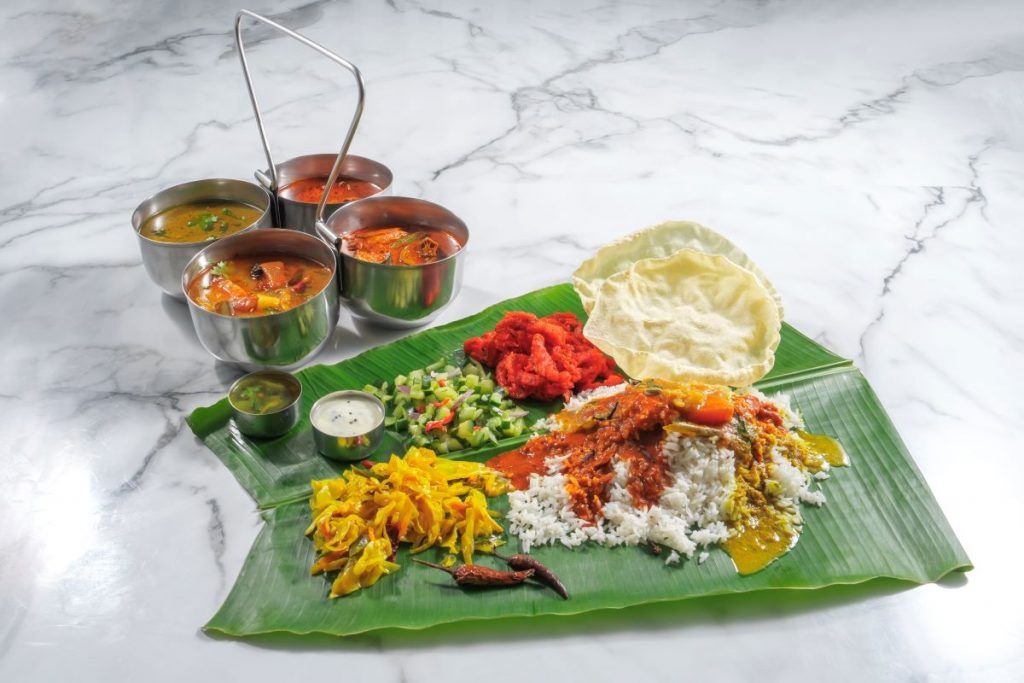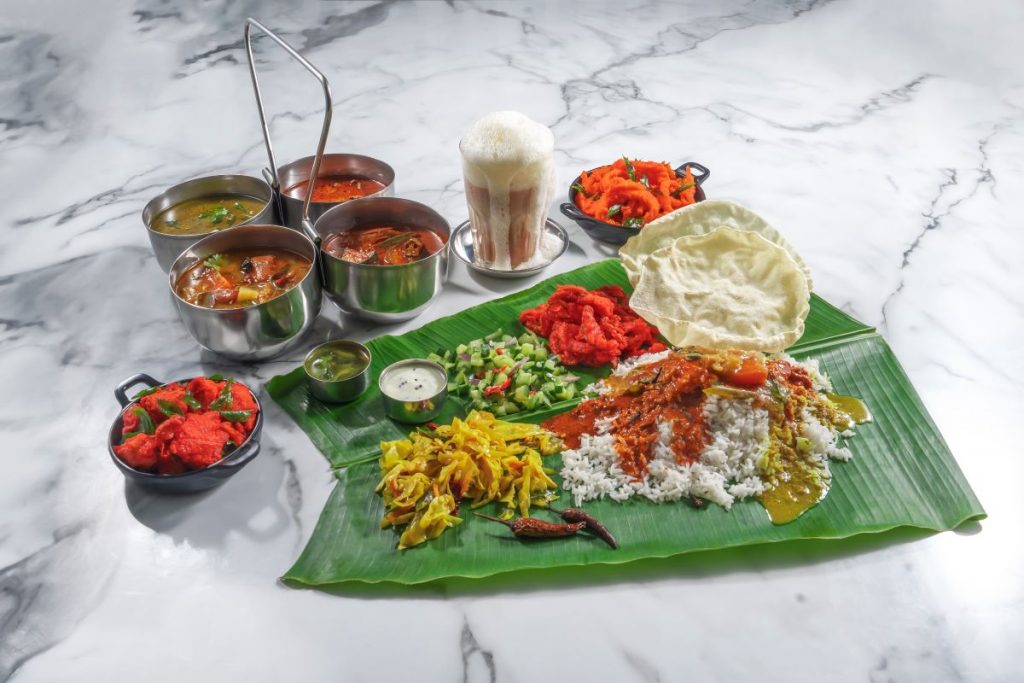There are a lot of cultural significance of banana leaf rice is a beloved and traditional Malaysian dish that holds deep cultural symbolism. It is a culinary tradition that showcases the cultural richness and diversity of Malaysia’s food traditions.
Malaysia, known for its multicultural society, boasts a delightful amalgamation of Malay, Indian, and Chinese culinary influences. Banana leaves have become an integral part of Malaysian identity, particularly associated with Indian culture, in serving rice dishes.
One renowned restaurant that specializes in serving banana leaf rice is BananaBro. This banana leaf rice restaurant takes pride in its authentic flavors and brings the essence of Indian food to the plate. Banana leaf meal is a hot food consist of steamed white rice, served on a banana leaf, accompanied by an array of delectable Indian dishes.
It does not only acts as a natural, eco-friendly plate but also imparts a unique aroma and flavor to the food. The ritual of eating banana leaf rice brings communities together, whether it’s for a quick bite at a street-side stall or a grand feast during religious ceremonies.
Over time, it has evolved to cater to different tastes and dietary preferences. Many variations now include vegetarian dishes, alongside traditional favorites such as fragrant curries, tangy chutneys, and crispy papadums.
It has transcended regional boundaries, becoming a national dish of utmost pride. The popularity continues to grow as locals and tourists alike appreciate the cultural heritage and delightful flavors associated with this Malaysian culinary tradition.
Cultural Significance of Serving Food on Banana Leaves

Serving food on banana leaves holds great cultural significance in many Indian culture in Malaysia. Both practical and symbolic reasons root the use of banana leaves as plates. In ancient times, people used banana leaves due to their availability and affordability. However, this practice has endured over time and has become an integral part of cultural identity and culinary journey
Meals on banana leaves reflects eco-friendliness and sustainability in traditional dining. Banana leaves, being biodegradable and abundantly available, offer a natural and environmentally friendly alternative to disposable plates. They have no negative impact on the environment and people can easily discard them without causing pollution.
Additionally, banana leaves lend a distinct flavor and aroma to the food. Their natural oils and textures enhance the taste experience, making it more enjoyable and authentic. Furthermore, the large surface area of the leaves allows for the placement of variety of dishes, creating a visually appealing and appetizing meal.
Furthermore, people often associate serving food on banana leaves with religious ceremonies and festive occasions. It symbolizes hospitality, purity, and abundance, reflecting the values and traditions of the Indian and Malaysian cultures.
In conclusion, the cultural significance of serving food on banana leaves goes beyond its practicality. It exemplifies eco-friendliness, sustainability, and the rich traditions associated with South Indian and Malaysian cuisines. People continue to embrace this age-old practice as a symbol of identity and a connection to the natural world.
Traditions Associated with Eating Banana Leaf Rice

The cultural symbol of eating food on banana leaves is deeply rooted in the traditions of South India and Malaysia. Banana leaf rice, a popular dish in both countries, showcases the rich Indian cuisine and serves as a reflection of the cultural identity of Malaysians.
Traditionally, the banana leaf rice meal consisted of hot, steaming white rice served on a fresh, vibrant banana leaf. The leaf symbolizes purity and cleanliness. To enhance the flavors, people would serve an assortment of Indian dishes such as curries, dals, and vegetables alongside the rice. The use of coconut milk in the curries adds a distinct flavor and aroma.
Serving banana leaf rice also involves certain rituals. To ensure optimal hygiene, people invariably clean and wipe each leaf with a piece of cloth. Additionally, the meal typically includes accompaniments like pickles, papadums, and a hard-boiled egg, providing a variety of tastes and textures.
BananaBro, offers authentic recipe from South India, preserves these by serving banana leaf meal in the traditional method. They embrace the culinary traditions of their Indian heritage and strive to offer an authentic experience to their patrons.
Over time, banana leaf rice has become more than just a dish. It has evolved into a national symbol of Malaysian food culture and a common sight in street vendors, hawker centers, and restaurants. Regardless of ethnicity, Malaysians from all walks of life appreciate and indulge in this beloved meal on banana leaves, making it a unifying and inclusive culinary experience.
Evolution of Banana Leaf Rice’s Significance Over Time
Banana leaf rice has deep historical roots in Malaysia, tracing back to South Indian cultural traditions. This iconic dish has evolved over time, adapting to modern tastes while preserving its cultural essence.
Originally, banana leaf rice consisted of hot white rice served on banana leaves, accompanied by a variety of flavorful Indian dishes. The use of banana leaves is symbolic, as the banana tree holds significant importance in Indian and Malay cultures. The leaves not only impart a unique aroma but also add visual appeal to the meal.
In the past, the Indian community and religious ceremonies were mainly associated with banana leaf rice. However, it has now become a beloved Malaysian dish embraced by people from all backgrounds. Malaysian cooking has incorporated the meal, making it available in restaurants, as well as at roadside stalls and hawker stalls.
As Malaysian cuisine has evolved, so too has banana leaf rice. Today, it is not uncommon to find innovative variations and fusion dishes, catering to the diverse tastes of contemporary diners. BananaBro, a leading restaurant, has taken the traditional banana leaf rice concept and added their unique twist. They offer an array of vegetarian and non-vegetarian dishes, along with options like roti canai and bitter gourd, all served on banana leaves.
BananaBro’s approach to this indian tradition reflects the ever-changing Malaysian food scene while staying true to the dish’s cultural roots. By incorporating new flavors and cooking techniques, they keep it alive and relevant for a new generation of diners. The evolution of banana leaf rice’s significance over time showcases the dynamic nature of Malaysia’s culinary journey.
Banana Leaf Rice and Malaysian Identity
Banana leaf rice is not just a popular dish in Malaysia, it is also deeply intertwined with the country’s national identity and special occasions. This culinary journey has gained popularity among Malaysians of different ethnic backgrounds, making it a symbol of unity in diversity.
What makes banana leaf rice special is its representation of the cultural fusion that exists in Malaysia. Originating from South India, this meal consists of hot, aromatic food served on a banana leaf, typically with white rice. It is a staple in Indian cuisine and a common sight in Malaysian households, roadside stalls, and hawker stalls.
BananaBro is not a typical indian restaurants. It has played a significant role in promoting banana leaf rice and showcasing the multicultural essence of Malaysia in culinary heritage aspect. By offering a wide variety of authentic Indian dishes, including vegetarian food, BananaBro has made this dish accessible to a vast majority of people from all walks of life.
The cultural significance of banana leaf rice goes beyond just its taste.
The Malaysian cultural heritage is represented by the banana leaf itself, as banana plants abundantly thrive in the country. The meal is often served with coconut milk, hard-boiled eggs, and various side dishes like bitter gourd and ikan bilis. Malay Dish and Malaysian culture overall integrate it.
Over time, banana leaf rice has evolved to become an integral part of Malaysian cuisine, reflecting the culinary traditions of the Indian community while being embraced by the wider Malaysian population. It is not only enjoyed in restaurants but also commonly served during religious ceremonies and celebrations.
In essence, banana leaf rice has become a beloved national dish that symbolizes the diversity, unity, and rich heritage of Malaysia. It is a testament to the country’s multiculturalism and its ability to embrace and celebrate different culinary traditions.
Conclusion
In conclusion, banana leaf rice holds cultural significance in Malaysia as it represents the amalgamation of Indian and Malay cultures. The tradition of serving food on banana leaves dates back centuries and is deeply rooted in Indian culinary practices. Over time, this wholesome and flavorful meal has become a symbol of Malaysian identity, bridging communities through its shared appreciation for delicious food.
Banana leaf rice not only showcases the diversity of Malaysian cuisine but also serves as a reminder of the importance of preserving cultural traditions. It is through dishes like banana leaf rice that Malaysian communities maintain a sense of pride in their heritage, passing down these culinary customs from one generation to the next.
When dining at BananaBro – a popular banana leaf restaurant, patrons have the opportunity to indulge in the authentic flavors and textures of banana leaf rice. Hence, experiencing the cultural significance of Malaysian cuisine firsthand. From the fragrant rice to the vibrant array of side dishes, including vegetarian food, each bite offers a glimpse into the rich tapestry of flavors that make this meal so beloved.
By embracing banana leaf rice and supporting establishments like BananaBro, we not only nurture our taste buds but also contribute to the preservation of Malaysian culinary traditions. So, why not embark on a culinary adventure and savor the delights of banana leaf rice today?

![[BananaBro] Exploring the Cultural Significance of Banana Leaf Rice in Malaysia](https://www.bananabro.com.my/wp-content/uploads/2023/12/Cultural-significance-of-banana-leaf-rice-in-malaysia.png)